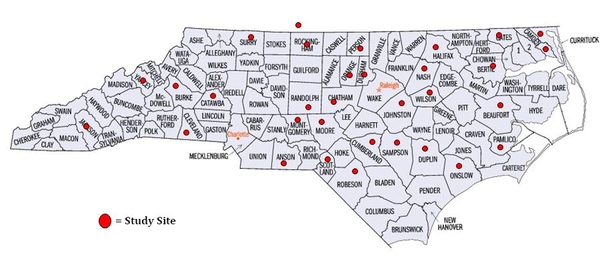Introduction
Policy and public sentiment are coalescing to promote renewable energy. The most economically available source in North Carolina is woody biomass. Harvesting biomass residues may create markets for diseased and damaged trees, reduce wildfire risk, lessen site preparation costs and allow opportunities to restore unique ecosystems. Studies suggest new markets may significantly increase the amount of harvested total stand biomass (Hess and Zimmerman, 2001). However, woody biomass residues from forest harvesting are important for carbon sequestration, nutrient cycling, wildlife habitat and water quality. Some have expressed concern that market-driven removal of woody biomass will adversely impact site conditions. The total amount of biomass that may be sustainably harvested is unknown.
To inform the dialogue on sustainability, the NC State University Extension-Forestry established a sampling study to characterize logger utilization and residual woody biomass across the state. Study sites covered all physiographic regions of North Carolina (Figure 1). On study sites prism sweeps for woody biomass (Bebber and Thomas, 2003) were used to quickly estimate wood residues left after harvesting. Estimated woody biomass residues were compared with scale ticket information from loggers, consultants and timber buyers. Logger utilization was developed using these collected data.
1 This sampling study is ongoing, analysis is based on results as of August 20th 2009.
2 Dennis W. Hazel was the principle investigator. Data analysis and study coordination was conducted by Nathaniel L. Osborne. Thomas R. Jones and Jonathan L. Murray collected the majority of measurements in the field. Research was funded by the North Carolina Biofuels Center.
Results
To date fifty-six harvest sites have been sampled in thirty-three counties. Logger utilization has been developed for twenty of these sites. Overall, loggers using chipping equipment left an average of 9.7 tons per acre across the harvest area (Figure 2). Loggers without chippers left an average of 8.8 tons per acre (Figure 3). On average, loggers using chippers harvested less high value products relative to those without chippers. Harvest residues and extracted pulpwood on chipped sites and traditionally harvested sites were not significantly different. On average the total amount of stand biomass per acre was greater on sites without in-woods chipping.
Merchantable Product Removed and Harvest Residues Left on Site

Figure 2. Chipped Sites. Comparison of sampled sites with in-woods chipping and without in-woods chipping as part of harvest operations. Harvest residues are based on all sampled sites, relative percentages are calculated over twenty harvest with removal information.
Figure based on field data collected as of July 29th, 2009.

Figure 3. Sites Without Chipping. Comparison of sampled sites with in-woods chipping and without in-woods chipping as part of harvest operations. Harvest residues are based on all sampled sites, relative percentages are calculated over twenty harvest with removal information.
Figure based on field data collected as of July 29th, 2009.
On average, chipped sites utilized less of the total available stand biomass. Chipped sites were relatively less variable in stand utilization than those with without chipping. On chipped and traditionally harvested sites, the minimum amount of total stand biomass utilized was 69% and the maximum was 96%. Sites with chipping always utilized between 85% and 95% of total stand biomass. Sites without chipping utilized between 69% and 96% of the total stand biomass.
| Harvest Area | Average Biomass Residues (tons/acre) | Total Stand Biomass Utilization (%) | |
|---|---|---|---|
| Without In-Woods Chipping | Northern Coastal Plain | 14.78 | 92% |
| Southern Coastal Plain | 9.58 | 83% | |
| Sandhills | 5.05 | 95% | |
| Upper Piedmont | ---- | ---- | |
| Lower Piedmont | 7.37 | 90% | |
| Western Mountains | 16.92 | 74% | |
| With In-Woods Chipping | Northern Coastal Plain | 14.59 | 91% |
| Southern Coastal Plain | 8.08 | 94% | |
| Sandhills | 3.28 | 95% | |
| Upper Piedmont | 8.76 | 95% | |
| Lower Piedmont | ---- | ---- | |
| Western Mountains | ---- | ---- | |
| Overall Average | 9.82 | 90% | |
Conclusions and Discussion
Results indicate loggers with in-woods chipping are more likely to harvest stands with less valuable timber. Although loggers have an additional harvesting component, the same amount of pulpwood is extracted and harvest residues are not significantly different. Results indicate that residual woody biomass varies greatly by region, species composition, site condition, and regeneration technique. More studies are needed to understand the relationship between harvest residues and these factors.
Increased consumption of woody-biomass products may promote harvesting poor quality stands. Without markets for woody biomass, many of these stands cannot be economically harvested. Results suggest we can protect harvest residues and limit competition with pulpwood markets.
References
Bebber, D and Thomas, S, “Prism Sweeps for Coarse Woody Debris”, Canadian Journal of Forest Research, 2003, vol 33, pages 1737-1743. ↲
Hess, George, and Dale Zimmerman. "Woody Debris Volume on Clearcuts With and Without Satellite Chip Mills." Southern Journal of Applied Forestry 24(4)(2001): 173-177. Print ↲
Publication date: Jan. 1, 2009
Reviewed/Revised: Sept. 28, 2022
N.C. Cooperative Extension prohibits discrimination and harassment regardless of age, color, disability, family and marital status, gender identity, national origin, political beliefs, race, religion, sex (including pregnancy), sexual orientation and veteran status.

